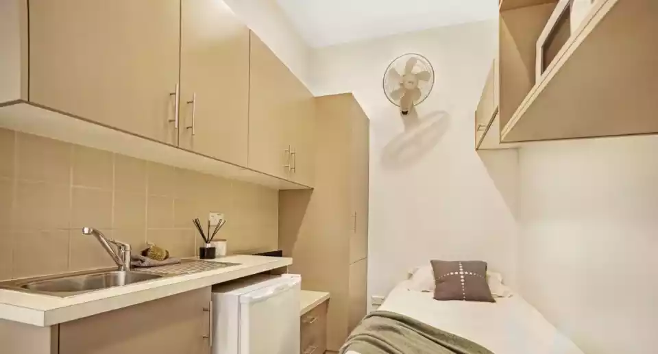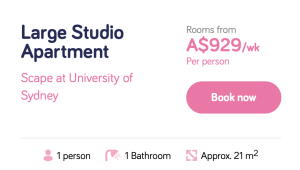
“My bed is right next to the cooking area, and the cramped space makes me feel like I’m living in the kitchen, which is right next to the bathroom.”
This is the daily life of a Chinese student studying in Sydney.

Education Export, Student Exploitation
Today, international education has become an important source of income for Australia, yet international students in Australia are facing increasingly difficult circumstances.
In the 2023-24 fiscal year, international education contributed as much as A$51 billion to the Australian economy, yet international students have long been excluded from affordable housing policies.
High Rents, Poor Conditions

In the first quarter of 2025, Domain’s rental report showed that the median rent for houses in Sydney had skyrocketed to A$775 per week, a year-on-year increase of 3.3%. For international students without a source of income, this means they can only choose to share a bedroom with many people or opt for low-quality housing with poor transportation links.
What’s worse, even if many people can afford high rents, the living conditions they get are far from reasonable.
“I paid five-star prices but ended up in a two-star room.”
This is Ariel’s assessment of the student dormitory she resides in. She pays nearly A$700 in rent each week yet can only occupy a room measuring just 14 square meters. This cramped and crowded space leaves her feeling incredibly suffocated. What’s worse, the air conditioner in the dormitory automatically turns off when no one is detected, and she is often awakened by the heat at night in summer. She must get up to turn on the air conditioner, which seriously affects her sleep and mental state.
Unlike Ariel, Enzo had to move out when his landlord suddenly raised the rent by 15%. With the semester ending, he couldn’t find a new place in time. He now sleeps in a friend’s living room, with no privacy and no stable routine.“Every morning at 6, I have to pack up the mattress so my friend can use the space to eat,” he said.
They’re far from alone. There are many international students who are experiencing the same bad housing predicament.
Housing Stress Becomes Mental Distress

Housing insecurity is not just a logistical challenge. It’s a psychological one. High rents and housing instability are eroding the mental health of international students. Research shows that housing instability, overcrowding, and high rent burdens significantly increase the incidence of psychological distress, and this causal relationship between housing stress and mental health remains significant in long-term follow-up studies. The Orygen also pointed out in its 2020 report that housing pressure, along with financial and employment difficulties, are the three key social factors affecting the mental health of international students, and are directly linked to an increased risk of psychological distress such as depression, anxiety, and isolation.
Even more alarming, the report finds that international students are less likely than locals to seek psychological help on their own. This reflects a long-standing lack of institutional protection and emotional support.
For those far from home and new to a foreign country, housing pressure and academic stress often overlap. Many struggle just to survive, let alone thrive.
Where is the support?
Although some government and university websites appear to offer accommodation support to international students, this support is merely superficial. Take the Australian government’s official platform, Study Australia, as an example. Its housing support page mainly provides rental advice, checklists, and precautions, but the information is fragmented and lacks practical guidance, making it difficult to truly alleviate the anxiety and helplessness that new students face when entering an unfamiliar rental market.
At the same time, although some universities offer a variety of dormitory options, they are unable to solve the housing difficulties faced by international students.
Firstly, there are limited dormitory places on campus. For example, according to the annual report data, at the University of Sydney only 2,500 dorm spots exist for over 33,000 international students. This means that the competition to apply for a school dormitory is extremely fierce.
Secondly, many universities choose to partner with commercial institutions to provide off-campus apartments for students such as Scape, UniLodge, Iglu. The prices of these apartments are generally very high, and the space is also very small. Despite being marketed as “officially recommended accommodation,” these apartments are entirely operated by commercial entities. Students must sign contracts independently, prepay rent, and bear financial pressures equivalent to those of renting on the open market. This “market-driven model endorsed by the university” not only blurs the university’s responsibility for housing but also leads many students to mistakenly believe this is part of “campus support.”

Broken Policies, Misplaced Blame
Although the rental predicament of international students is already very serious, the policy response is still shallow, or even worse, misdirected.
Education Minister Jason Clare publicly stated in 2024 that the government would adjust the pace of student visa processing to match housing supply capacity, attributing part of the housing shortage to the surge in international student numbers. Meanwhile, Opposition Leader Peter Dutton more directly proposed cutting 80,000 student visas over two years to ease pressure on housing and infrastructure.
This policy ignores the real causes of the housing crisis,while reinforcing the harmful view that international students are a burden, adding both psychological and policy pressure to an already vulnerable group.
Solutions That Can’t Wait
- Increase on-campus accommodation beds to alleviate the imbalance between supply and demand.
- Provide “priority beds” and rent subsidies for low-income and first-time international students.
- Regulate off-campus cooperative accommodation models and restrict commercial dormitory pricing.
- Establish an “International Student Housing Fund” to support the construction of affordable student apartments.
Have you faced rental issues in Australia as an international student?
Share your story in the comment section and participate in the voting below.
To join the broader conversation, use the hashtag #StudentRentStruggles on social media.
Your voice matters!and the more we speak, the harder it becomes to ignore.





Be the first to comment